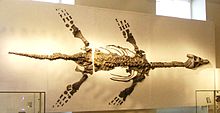Atychodracon megacephalus
|
Atychodracon Temporal range: Late Triassic-Early Jurassic, 201 Ma |
|
|---|---|
 |
|
| Referred specimen LEICS G221.1851, New Walk Museum | |
| Scientific classification | |
| Kingdom: | Animalia |
| Phylum: | Chordata |
| Class: | Reptilia |
| Superorder: | †Sauropterygia |
| Order: | †Plesiosauria |
| Family: | †Rhomaleosauridae |
| Genus: |
†Atychodracon Smith, 2015 |
| Type species | |
|
†Atychodracon megacephalus (Stutchbury, 1846) |
|
Atychodracon is an extinct genus of rhomaleosaurid plesiosaurian known from the Late Triassic - Early Jurassic boundary (probably early Hettangian stage) of England. It contains a single species, Atychodracon megacephalus, named in 1846 originally as a species of Plesiosaurus. The holotype of "P." megacephalus was destroyed during a World War II air raid in 1940 and was later replaced with a neotype. The species had a very unstable taxonomic history, being referred to four different genera by various authors until a new genus name was created for it in 2015. Apart from the destroyed holotype and its three partial casts (that survived), a neotype and two additional individuals are currently referred to Atychodracon megacephalus, making it a relatively well represented rhomaleosaurid.
The type species of Atychodracon was first described and named by Samuel Stutchbury in January 1846, as a species of the wastebasket taxon Plesiosaurus. The specific name means "large-headed" in Greek in reference to the very large skull compared to the rest of the skeletal elements "Plesiosaurus" megacephalus had, relatively to other / actual species of Plesiosaurus. The pliosauroid nature of "Plesiosaurus" megacephalus remained unnoted until a revision by Richard Lydekker in 1889. Lydekker recognized the rhomaleosaurid affinities of "P." megacephalus, but because he and Harry G. Seeley "refused steadfastly to recognize the generic and specific names proposed by one another", he moved "P." megacephalus to the genus Thaumatosaurus which was regarded by him as a replacement to Seeley's Rhomaleosaurus - creating the new combination T. megacephalus.
...
Wikipedia
